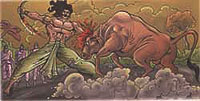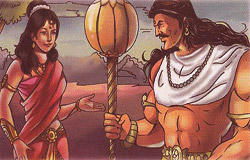SAMPATI
Sampati Loses his wings
Sampathi and Jatayu, when young, used to compete as to who could fly higher. On one such instance Jatayu flew so high that he was about to get seared by the sun's flames. Sampati saved his brother by spreading his own wings and thus shielding Jatayu from the hot flames. In the process, Sampati himself got injured and lost his wings. As a result, Sampati lived wingless for the rest of his life.
Sampati in Ramayana
Sampati proved instrumental in Sita's search later on in the Ramayana. His role comes when the search party sent to the south, Led by Angada with Hanuman and Jambuvana, exhausted, thirsty and depressed, reach to the southern end of the land. They have the endless sea before them, and still no clue of Sita. Disappointed, everybody just collapses on the sand, unable as well as unwilling to move or act any further. Suddenly, they all hear a voice which says - "I will feast today. I shall be ever grateful to God for having such delicious meal walk to my doorsteps all by itself". Everyone looks in the direction of the voice, and see a huge vulture progressing towards them slowly, saying these words. At that moment, Jambavan says - "Life is so ironical. One is this vulture, who is planning to eat this disappointed lot, too exhausted to defend themselves - and defeated in this search for Seeta Mata; too guilty even to wish to live any further. And one was that Vulture Jatayu, who gave his life trying to save Sita Mata from the clutches of Ravana."
The vulture froze as soon as he heard the word "Jatayu". " Jatayu? Did you say Jatayu? What happened to him? Please tell me." Jambuvana told the story of Jatayu and his bravery. The vulture's eyes were moist at the end of the story. His throat choked; he said - "My name is Sampati. Jatayu was my brother. It has been ages since I have heard of any news from him. I hear a news now - news that he is no more!" Then, collecting himself, he says - "I am grateful to you, Sir! You have brought me the news of my brother. I shall return this favour. This lady Sita you are searching so fervently for; I know where she is."
Sampati tells about Lanka
Everybody jumped as soon as he said this. They listened with utmost concentration, as Sampati continued. " 100 Yojan from here is Lanka, the kingdom of Ravana. Some days ago, I had seen him flying in his Pushpak, landing at Lanka with a beautiful lady with him, forcibly being taken into Lanka and banished in one of the Vatika. I now know after listening to your story, She was Sita."
"Good you gentlemen came. Now she will be remedied of her agony. Everyday, I used to watch her, sitting beneath that tree in that vatika - distraught, waiting for someone. Her wait will end now."
Jambuvana asked - " It seems from your words that you .. You can see her !!" "Why, Of course I can!" Sampati said. "We - descendants of Garuda, are blessed with very superior vision. I am old now, but still, 100 Yojans in not much for me."
Griddhraj Parvat, situated in Satna district in Madhya Pradesh, is believed to be the birthplace of Sampati.
Sampati and Jatayu’s Competition
When both the brothers Sampati and Jatayu were young they had great powers. Once they decided to go and touch the sun. They flew up and up in the sky and due to sun’s hot flames Jatayu the younger brother asked his brother that he can no longer go and want to return to the earth and Sampati saved his brother by spreading his own wings and thus shielding Jatayu from the hot flames. Jatayu returned but Sampati did not return and lost his wings in sun’s hot flames. Sampati lived wingless for the rest of his life.
source : http://en.wikipedia.org/wiki/Sampati
%%%%%%%%%%%%%%%%%%%%%%%%%%%%%%%%%%%%%%%%
 |
 |
 |
`
In Hindu theology, Sampati (Sanskrit: सम्पाति Sampāti, Indonesian: Sempati, Thai: Sampathi, Tamil: Campati, Malay: Dasampani) was one of the two sons of Aruṇa (the charioteer of Surya) and was the brother of Jatayu. Sampati lost his wings when he was a child.Sampati Loses his wings
Sampathi and Jatayu, when young, used to compete as to who could fly higher. On one such instance Jatayu flew so high that he was about to get seared by the sun's flames. Sampati saved his brother by spreading his own wings and thus shielding Jatayu from the hot flames. In the process, Sampati himself got injured and lost his wings. As a result, Sampati lived wingless for the rest of his life.
Sampati in Ramayana
Sampati proved instrumental in Sita's search later on in the Ramayana. His role comes when the search party sent to the south, Led by Angada with Hanuman and Jambuvana, exhausted, thirsty and depressed, reach to the southern end of the land. They have the endless sea before them, and still no clue of Sita. Disappointed, everybody just collapses on the sand, unable as well as unwilling to move or act any further. Suddenly, they all hear a voice which says - "I will feast today. I shall be ever grateful to God for having such delicious meal walk to my doorsteps all by itself". Everyone looks in the direction of the voice, and see a huge vulture progressing towards them slowly, saying these words. At that moment, Jambavan says - "Life is so ironical. One is this vulture, who is planning to eat this disappointed lot, too exhausted to defend themselves - and defeated in this search for Seeta Mata; too guilty even to wish to live any further. And one was that Vulture Jatayu, who gave his life trying to save Sita Mata from the clutches of Ravana."
The vulture froze as soon as he heard the word "Jatayu". " Jatayu? Did you say Jatayu? What happened to him? Please tell me." Jambuvana told the story of Jatayu and his bravery. The vulture's eyes were moist at the end of the story. His throat choked; he said - "My name is Sampati. Jatayu was my brother. It has been ages since I have heard of any news from him. I hear a news now - news that he is no more!" Then, collecting himself, he says - "I am grateful to you, Sir! You have brought me the news of my brother. I shall return this favour. This lady Sita you are searching so fervently for; I know where she is."
Sampati tells about Lanka
Everybody jumped as soon as he said this. They listened with utmost concentration, as Sampati continued. " 100 Yojan from here is Lanka, the kingdom of Ravana. Some days ago, I had seen him flying in his Pushpak, landing at Lanka with a beautiful lady with him, forcibly being taken into Lanka and banished in one of the Vatika. I now know after listening to your story, She was Sita."
"Good you gentlemen came. Now she will be remedied of her agony. Everyday, I used to watch her, sitting beneath that tree in that vatika - distraught, waiting for someone. Her wait will end now."
Jambuvana asked - " It seems from your words that you .. You can see her !!" "Why, Of course I can!" Sampati said. "We - descendants of Garuda, are blessed with very superior vision. I am old now, but still, 100 Yojans in not much for me."
Griddhraj Parvat, situated in Satna district in Madhya Pradesh, is believed to be the birthplace of Sampati.
Sampati and Jatayu’s Competition
When both the brothers Sampati and Jatayu were young they had great powers. Once they decided to go and touch the sun. They flew up and up in the sky and due to sun’s hot flames Jatayu the younger brother asked his brother that he can no longer go and want to return to the earth and Sampati saved his brother by spreading his own wings and thus shielding Jatayu from the hot flames. Jatayu returned but Sampati did not return and lost his wings in sun’s hot flames. Sampati lived wingless for the rest of his life.
source : http://en.wikipedia.org/wiki/Sampati
%%%%%%%%%%%%%%%%%%%%%%%%%%%%%%%%%%%%%%%%















